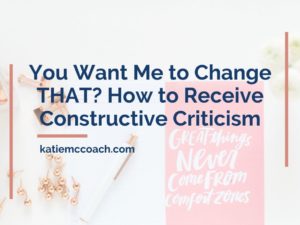
The moment has come. You sit in front of your computer; anxiety claws at your stomach, your hands twitch, but finally, finally, you force yourself to open that email. The one you are equal parts excited for and dreading. But, you have no choice. This is the next step.
What in the world could work a writer up like this?
Constructive criticism. That exciting and horrible moment when it’s time to read the notes from your critique partner(s), beta reader(s), and editor(s). And the one thing this feedback all has in common: it’s a list of what’s—and I’m using air quotes as I type this—‘wrong’ in your book.
Receiving constructive criticism is difficult. We don’t all have naturally thick skin. Some of us have spent years building up those layers. But for most, hearing anything negative about our work is the last thing we want to do. However, receiving feedback on your writing is an inevitable part of publishing, and I’m here to bring you the truth: it doesn’t have to tear you apart.
I’ve been a writer for a majority of my life, and for the past six years I’ve helped other writers as a developmental editor. I am not a stranger to giving or receiving feedback. In this article, I’ll discuss tools and methods for receiving constructive criticism that not only have worked for me, but that have been tested by writers from all experience levels. In this article, you’ll learn how to process feedback, embrace it, how to make it work for your story, and even when to ignore it. Just as writers develop techniques for crafting stronger manuscripts, they also must hone their skillset of processing constructive criticism. My goal is to not only give you methods for feeling comfortable and—gasp—excited for feedback, but also to know how to use the feedback to your advantage. This is another tool that will help you craft a stronger version of your story, so why aren’t you sharpening it?
As you read this article, remember that criticism and constructive criticism are two very different things. Criticism, by definition, is the act of criticizing unfavorably. Constructive is an adjective meaning promoting improvement or development. Without being constructive, criticism can be cruel and unnecessary. That’s not what we are here to talk about today (although that’s definitely a topic to be explored).
I’m here to talk about constructive criticism as it applies to writing. This is feedback on your writing and story that is helpful in addressing the strengths and weaknesses. We don’t love the word “weakness” when talking about writing, but we all have them—parts of our stories that need further development. And the major thing to remember is that it’s OK to have them. It gives you something to work on, to grow, to develop. Don’t think you are less of a writer for them. This is important to keep in mind when you receive feedback that is more negative than good. Remind yourself that knowing these things will only make your writing stronger and more powerful.
Remember: The goal of constructive criticism is to help a writer grow.
Here are 12 tried and true tips for processing constructive criticism:
Embrace the emotions
The first time I received tough, brutally honest feedback, I cried. Okay, fine, I’ve cried many times over the years, even when I think I’m an expert at hearing what’s not working in my story. Our work represents more of ourselves than we sometimes admit, and so when that’s criticized, it feels like we—our very beings—are being criticized. Before you try to tackle feedback, I want you to embrace the feelings. Let yourself be hurt. Let yourself hate the words said about your piece. Cry. Don’t try to push the emotions aside, because you’ll most likely find that they crop up in the middle of revisions. And who knows what foreign, uninhabitable places that could take your work?
It’s not personal
After you’ve felt all the feelings, I want you to chant this mantra if you are apt to forget it: It. Is. Not. Personal. I believe it takes multiple times of hearing feedback before you can do this well. When feedback comes to us and it feels like it’s directed in a harsh light, remind yourself that this is the response someone is having to your story. This is not a response on how they feel about you. It’s their interpretation of the work.
There’s so much going on in a person’s life day to day. Everyone comes to a new book with a different set of experiences and biases. You might have a plot point in your novel that too closely resembles an experience in their life. Maybe there’s one line of dialogue from your Hero that sets a reader off because their ex-husband said it to them all the time. Maybe they’re just having a bad day. These things are out of your control.
Also, consider personal preference of the reader. If you have a CP or Beta reader who is unable to be fairly objective, keep that in mind. I’ve been in many critique groups where someone hates romance and their feedback shows that.
Listen
And I mean, deeply, truly listen. I see this more than you’d think—a writer doesn’t want to hear any feedback beyond validation. How fair is that to your critique partner or editor? Or even your readers? Hear what people notice, what they like, what they struggle with. Right now, just listen. Don’t try to explain it away. Don’t dismiss it. Don’t defend. Listen to all of it.
Sit on it
After listening, before defending, mule the feedback over. Don’t make rash decisions. I see some authors who are so eager to get notes that they’ll change anything someone mentions, without considering if it’s helping tell the story they want to tell. I also see many writers unwilling to listen to anything they don’t immediately agree with. I completely empathize with the urge to ignore things that don’t work for you, at first glance. But this can be detrimental to your work. It’s usually the most painful of constructive criticism that ends up being the most valuable. That time that made me cry? It was because someone called me a newbie romance writer. I was crushed. I studied writing in college, I’d been writing for years—how could they see me as so new? But after I sat on their notes for a while, I realized that in many ways, they were right. My work was full of adverbs, cardboard characters, unrealistic dialogue, and telling lines out the wazoo. It was hard to hear, but that’s probably been the most helpful critique I’ve ever received. (Even though this story had a nice ending, I recommend never calling another writer a newbie).
At a minimum, give yourself one full day with a night of sleep to mule feedback over.
Make lists
I haven’t met a writer who doesn’t love a good list. This will be helpful when looking at suggestions for the story. I want you to craft two lists: a “yes” list and a “maybe” list. I’m sorry, but you do not get to create a “no” list. All “no’s” equal “maybe.”
The yes list: Some suggestions will hit you in your gut with their astounding rightness. You’ll know without a doubt that the addition or change will enhance your vision, or that they pinpointed something you couldn’t put your finger on or articulate but you knew was an issue. This is a time when we rejoice after constructive criticism.
The maybe list: This list consists of everything else. Things you think make sense but need time to mule over more, ideas that are out of left field, and even the notes you want to scream, shred, and yell at. It all goes here.
Don’t “yes” it all
Part of why it’s important to make these lists—before beginning revisions—is to make sure you don’t “yes” too much of it too soon. I see many writers fall under the pretty, sparkly, trap of doing everything that’s suggested and losing the entire voice or vision of their book.
Seriously, whose book are you writing? If you yes everything you hear, it certainly won’t be your book anymore.
I did this with a short story I wrote. The majority of readers seemed to grasp onto a vision I hadn’t intended. So I listened to them completely and made tons of changes. The next time I showed it, they were lost. More importantly, I hated the story I had written. It wasn’t what I was trying to tell at all. So the third time, I revised the story based on my goals, based on feedback from those who seemed to understand my goals, and I dissected the feedback I didn’t connect with to understand why they were going in that direction. What about my story, my writing, was giving them a different vision? Finally, I had a story that was similar to my original vision, and the reaction to this new piece was unforgettable. It wasn’t blowing them away or anything—ha, I wish—but they saw what I saw, they connected, and their new feedback actually made sense for this story. One person even said, “This is what you meant to do the first time, isn’t it?”
The one thing I encourage you to keep in mind as you go through feedback is to ask yourself this: How does it serve your story?
Ask questions
As you begin to root through the feedback, you’ll come across notes that you may not understand. Either they don’t make sense, you have no clue what they are referencing, or you don’t see how they pulled that from the book. Were they even reading the same thing you wrote? This is very common, because remember, everyone comes to the story with different backgrounds and reading habits. Usually, this is more common when you receive feedback from beta readers, only because they are approaching it from a reader angle that generally falls under the overall question: do I like this or not? Critique partners are great at giving advice that fits your style, because they are familiar with your work, they’ve known your intention for a while, and they can help pick out areas that need improvement. Editors see your intended vision (even if it’s not all on the page yet), and aim to be objective in feedback so they can pinpoint the specific reasons your vision isn’t clicking with the reader, and tips for taking the story there.
For feedback that doesn’t make sense to you, do not hesitate to ask questions. For example, your reader says your Heroine is unlikeable, but they didn’t give an explanation as to why. Asking them questions will help you determine if, say, the Heroine’s motivation isn’t believable (or relatable) for her goal, or her dialogue is rude and dismissive, or she’s missing her Save the Cat! moment(s). This will help you determine how to revise and what to revise. Also, this is a good way to brainstorm. See if they feel changing one small detail early in the book will change their perspective on the Heroine.
If you can’t ask questions of your reviewer, use trusted people to talk it out. A friend of mine received beta reader feedback that she was struggling to work out, so she talked it out with her critique partners. After that, she could address those suggestions in her revisions in a way that made sense for her story.
Another tip; if you have the opportunity to ask questions before sending your work for feedback, consider doing so. This is valuable when working specifically with beta readers and large critique group settings. When I bring a piece of writing into a critique group, I tell the group the main things I want out of this session. For example, when sharing chapter one of my work, I told my group that all I want to know is if the chemistry between my Hero and Heroine is believable, compelling, and hot. The other reason this is so useful? It helps limit the amount of general like/dislike personal preference feedback that can derail your revisions.
Many people use a list of reader questions to send to their beta readers. You can quickly find tons of these lists via Google. Another great place to grab questions? Judging scoresheets from chapter contests.
Use it as inspiration
Not all advice is right, as we’ve discussed. But sometimes the direction of the feedback is right, but the execution isn’t. Use this as inspiration. Does their note make you look at a scene or character in a different way? Did it get you thinking outside of the box? Don’t look at someone listing ideas as them trying to write your book for you—use their ideas as a starting point. I do this all the time with my writers, because it almost always gets them thinking of new ways to approach the work, and I swear their ideas are 10x better than mine would ever be. Because you know your story best.
Try new tools
Every writer has a different method for approaching revisions and feedback. Try new tools/methods to find what works best for you.
-
Address big picture notes first, before the sentence-level things. Or vice versa.
-
Go one chapter at a time.
-
Pick one big problem to address at once. For example, in one pass only focus on how to enhance the character’s motivation.
-
Shrink your document to tiny font, print the whole thing out, and then lay the physical copies out before you to look at it from a top down view. This helps visualize the overall manuscript.
-
Use Post it notes to move chapters or scenes around.
-
Use different colors to highlight the different pieces of feedback on the edit letter/CP notes. Red = things to delete, green = things to expand, purple = line items, yellow = character notes.
-
Create a new document to work on revisions so you don’t replace anything in your manuscript until you are ready.
-
Save deleted lines, scenes, and characters in a separate document.
Find your people
Working with the right person/people is a huge part of receiving feedback that’s right for you. When picking critique partners, beta readers, and editors make sure your writing is something they want to read, that they like and understand your genre, appreciate your writing voice, and they can see your vision. Be sure there’s equal respect between you. And if you aren’t sure, test them out first. If you want a compliment sandwich, work with someone who gives constructive criticism that way, and not someone who gives it to you straight. Or vice versa. It takes time finding the right people. Don’t let this stop you from searching.
Do what’s best for your story, not your ego.
Rule of thumb—if three or more people give the same piece of feedback, you can not ignore it. Even if you hate it. Even if you think it doesn’t match your vision. Use the steps above to determine why they are saying this. And make sure your revisions address it.
And ultimately, remember, this is YOUR story.
Constructive criticism does not have to be something you dread. I want you to look forward to getting critiques so you can develop your skills and craft your best story. The more you do this, the better it will be. You will soon find yourself automatically sorting the feedback and knowing how to apply it. Until then, I hope these steps prove useful throughout your feedback journey.
By the way, are you thinking about traditionally publishing? Need help with your query letter? Download my Poppin’ Query Letter template for FREE.
Connect with me on:
Join the FREE Writing with Coach McCoach writing support community HERE.


 Download your free copy of these 8 tried-and-true strategies to stop self-doubt and imposter syndrome as a writer. And, build the power to resist it in the future.
Download your free copy of these 8 tried-and-true strategies to stop self-doubt and imposter syndrome as a writer. And, build the power to resist it in the future.
Constructive criticism does not have to be something you dread. I love hearing this